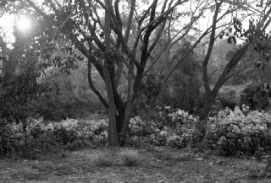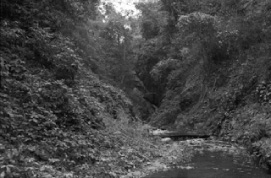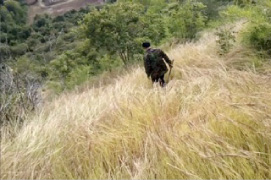| |
| |
|
|
|
|
| Kornkrit Jianpinidnan |
| b. 1975, Chiang Rai; lives and works in Bangkok |
| |
| Kornkrit Jianpinidnan studied print-making and photography at the Faculty of Fine Art, Chiang Mai University, before moving to Bangkok. He is one of Thailand’s leading fashion photographers. In his gallery practice, Kornkrit marries technical finesse with a romantic vision that is poetic and acutely personal. His recent solo exhibitions have included In the white field, I long for a zebra, VER Gallery, Bangkok (2009), Worry and Love, F Gallery, Chiang Mai (2007) and A ghost story, The Art Center, Chulalongkorn University, Bangkok (2006). He has participated in group projects including the 1st Singapore International Photography Festival (2008), Bangkok Bangkok (Kunsten Festival des Arts, Brussels and La Capella, Barcelona, 2005), Soi Visual Night at Super Deluxe, Tokyo (2004) and Pause (the 4th Gwangju Biennale, 2002), as well as recent collaborations with Pichet Klunchun and Montri Toemsombat. Kornkrit’s provincial landscapes trace the powerful correspondence between place and memory. Located not in the wilderness, but on its fringes, they are studies in presence and absence, indexing the accumulation of the past, and its erasure. His most recent work explores how social and oral history come to be inscribed on the rural environment. |
|
A Conversation with Kornkrit Jianpinidnan
|
David Teh: Where were these pictures taken?
Kornkrit Jianpinidnan: The Worry and Love series was taken when I revisited Chiang Mai in 2006-07, for a documentary job at Ban Yang village. The district had been hit by flash floods and landslides in 2006. My starting point for the series was a memory of a ‘depth of field’ class when I was studying photography, of looking through a layer of rain at the landscape behind.
DT: So what is the ‘erasing process’?
KJ: I worked with people from my past, who still lived in Chiang Mai; I watched them interact with spaces that had been lodged in my memory since I had lived there. My first idea was to do some post-production, to create something magical. In one of the images, (No.1) I retouched my friend Santipap, realising his wish to be pregnant. After exhibiting these images in Chiang Mai, I became obsessed by the audience’s reactions: some laughed, some marveled, and it made me think about how we perceive the impossible, about magic… The appearance of human figures gives to the landscape a form and an attitude, so I decided to erase the figure from the image, leaving just shadows, as a trace of experience… It was like editing, rewinding the tape and processing a memory into something new. It was a way of thinking about reality and virtual reality, of thinking about landscape in terms of photomontage… With this idea of erasing, I revisited the places of my memories. When I saw the tree (No. 4), it seemed to me like a door to a cave in The Lord of the Rings. So I took a picture of the guide who took me to this tree, and of the surrounding area. It was the last destination on that trip. For the other images – No.12 and No.10 (in the canal) – I had a more objective interest in what was visible.
 |
|
Kornkrit Jianpinidnan,
Worry and Love (erasing process no.8/08), 2008.
Photomontage, inkjet print on EPSON fine art paper |
DT: Perhaps the erasure of the figure doesn't make the photo any more or less real, but rather, opens a dimension of time in the landscape. Like the landscape has its own memory… Sometimes you work with video too, as in your Phraya Prab project. What's the relation between your photography and the moving image? Is cinema an inspiration?
KJ: In my early work I tended to think in terms of the snapshot, of capturing a moment in time. In the Neo-Romantic series (1998), I looked for the unexpected moment, the accidental, between the moment and what follows. This instant becomes a scene for the audience, a reality, a situation confronted in time and space; it can make something happen. But the moving image gives more of a context – as in the Phraya Prab video – and it can lead to a point of satisfaction. For me, the still image takes us straight to the most important point of being, to the immortal or the unforgettable... Cinema makes the imagination move, perhaps it’s more about the future than the still? It can stimulate fantasies – many times I’ve been stuck in its trap.
DT: The composition of your images is often ‘all-over’ – like abstract expressionism –distributed across the whole surface. Nature has been ‘cropped’, rather than framed. There’s the suggestion of a path, the hint of a form, something to be approached. But it’s momentary, as if the form could only appear right here, from this point of view.
 |
|
Kornkrit Jianpinidnan,
Worry and Love (erasing process no.12/09), 2009.
Photomontage, inkjet print on EPSON fine art paper |
KJ: In my compositions, the visible field is cropped, as a surface layer. For the illusion of texture I sometimes leave some real air, or light coming through when the sun is in front of the camera. This is the magic moment I wish for, that frozen zone is overwhelming. It's like the landscape itself is hallucinating, haunted by memories. What do you think about Whistler’s Nocturne in Black and Gold: the falling rocket?
 |
|
Kornkrit Jianpinidnan,
Tales from Phraya Prab Mountain, 2011.
Digital video still |
DT: I’ve noticed this in several of your photos – the ‘air or light coming through’ – like the ‘screen’ of the image is permeable. I see this admission in Apichatpong’s work too. And in Whistler's famous painting of the fireworks, with its shadowy figures (one of them erased) by the Thames… Perhaps we could place your work in the heroic tradition of the sublime – the romanticism of Friedrich, Turner – the pre-history of modernism’s ‘all-over’ painting. Light is totally diffused, scattered. What does this mean to a photographer?
KJ: I was thinking about another painting you talked about, in Khon Kaen, of the housemaid with the milk jug (Johannes Vermeer, The Milkmaid, c.1660). But the nocturne is more abstract. The title, too, refers to a present moment of perception. This is the still image with the idea of movement. Artificial light makes something appear, like dharmic truth, making you aware of what’s going on around you…
By correspondence, Bangkok and Singapore, February 2011 |
|
| |
|
|
|
|

